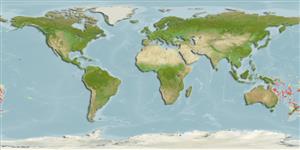分类 / Names
俗名 | 同种异名 | Catalog of Fishes(属, 种) | ITIS | CoL | WoRMS | Cloffa
Teleostei >
Callionymiformes (Dragonets) >
Draconettidae (Slope dragonets)
Etymology: Centrodraco: Greek, kentron = sting + Greek, drako = dragon (Ref. 45335); atrifilum: Named for the black filament on the second spine of the first dorsal fin; Latin 'ater' for black and ‘filum’ for thread.
More on author: Fricke.
Environment: milieu / climate zone / depth range / distribution range
生态学
海洋 底中水层性; 深度上下限 437 - 640 m (Ref. 84091).
Western Pacific: Australia.
大小 / 重量 / 年龄
Maturity: Lm ? range ? - ? cm
Max length : 2.1 cm SL 雄鱼/尚未辨别雌雄; (Ref. 84091); 3.4 cm SL (female)
简单描述
检索表 | 型态特徵 | 形态测量图
This species is distinguished by having the following characters: anal fin rays 12-13; second dorsal fin rays, 13-14; first dorsal fin with second spine elongate and filamentous in both sexes, the second dorsal fin with no filaments in males; male body colour pattern dorsally with 3 pairs of vertical dark brown streaks, followed by a single saddle below the end of the second dorsal fin and on the caudal peduncle (Ref. 84091).
Specimen was collected with a beam trawl, probably on soft bottom for species of Centrodraco usually occur on patches of soft substrate on the continental slope. Extremely rare in collections, and probably also biologically rare (Ref. 84091).
Life cycle and mating behavior
成熟度 | 繁殖 | 产卵场 | 卵 | 孕卵数 | 仔鱼
Fricke, R., 2010. Centrodraco atrifilum, a new deepwater dragonet species from eastern Australia (Teleostei: Draconettidae). Stuttgarter Beiträge zur Naturkunde A, Neue Serie 3:341-346. (Ref. 84091)
世界自然保护联盟红皮书 (Ref. 130435: Version 2024-2)
人类利用
工具
特别资料
下载 XML
网络资源
Estimates based on models
Preferred temperature (Ref.
123201): 6.7 - 10.2, mean 7.7 °C (based on 62 cells).
Phylogenetic diversity index (Ref.
82804): PD
50 = 0.5001 [Uniqueness, from 0.5 = low to 2.0 = high].
Bayesian length-weight: a=0.00389 (0.00180 - 0.00842), b=3.12 (2.94 - 3.30), in cm total length, based on all LWR estimates for this body shape (Ref.
93245).
营养阶层 (Ref.
69278): 3.1 ±0.4 se; based on size and trophs of closest relatives
Fishing Vulnerability (Ref.
59153): Low vulnerability (10 of 100).
